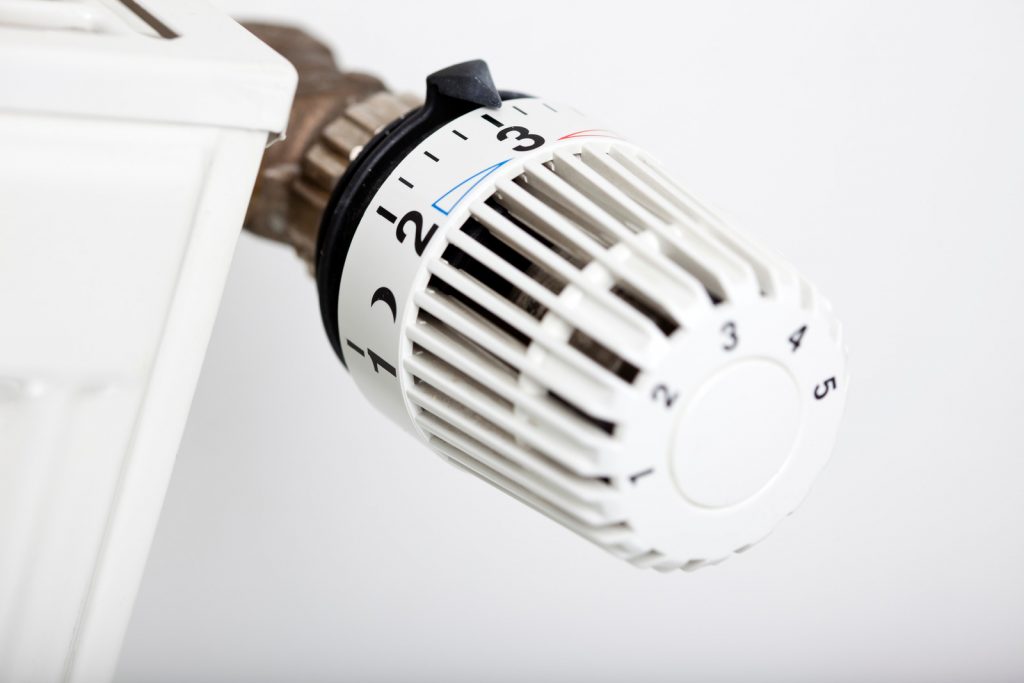Thermostatic Radiator Valves (TRV), also called radiator thermostats or radiator valves are connected to the pipework on a radiator. They give you more control of individual room temperatures. So you can keep some rooms warm and others that are not used cool. But as there are only a few number settings on them, there is no set temperature that correlates with the numbers, but the numbers represent a range.
What range of temperatures can you expect when you turn the dial on them? Here, we find out.
What are Thermostatic Radiator Valves (TRV)?
TRV’s work by sensing the air temperature around them in the room. They have a sensor and a body that work together to control how much heat the radiator needs to put out. The numbers on the valve head represent a sliding scale between 0-5 according to the level of comfort that you want and is not a precise temperature.

What temperatures are the numbers on the TRV?
As a general guide, the following table shows the temperature of the room that relates to the TRV symbols and numbers:
| TRV Number | Temperature setting | Room Type |
| 0 | Closed/Off | |
| * | Frost Protection Setting 4-7°C | Attached Garage |
| 1 | 8-12°C | Unoccupied Basement/Cellar |
| 2 | 13-17°C | Utility Room |
| 3 | 18-21°C | Bedroom |
| 4 | 21-23°C | Living Room |
| 5 | 23-29°C | Fully Open Max. Temperature |
the number system shows a range of heating, not specific temperatures. The higher the number the greater the temperature. The temperature at which the valve operates depends on factors such as the water temperature flowing through the radiator, free air flow around the TRV, the size of the room, and any heat loss in that room.
How TRV’s work
A TRV has a temperature sensor and a self-regulating valve body that work together to control the flow of hot water into the radiator. When the TRV is turned to a higher number setting, it allows more hot water from the boiler to the radiator. This way you can control the temperature in each room that has a TRV installed.
The opposite works with a lower number setting. it adjusts the flow of water into your radiator depending on the setting.
But, turning the TRV to a higher setting will not make the room heat up any faster because this depends on the boiler setting and the radiator size. Also, the TRV cannot switch the boiler off or on when it senses the temperature needs to be changed.
How much do TRV’s cost?
Prices for TRV’s start from £20 each from most stores. Prices vary depending on material and style. You will need one for each room you want to control the heating in rather than just depending on the size of the radiator.
Can TRV’s reduce heating bills?
TRV’s, when used correctly can be very helpful in reducing energy bills. For example, a TRV in a room that isn’t occupied can be set to the lowest setting so the boiler doesn’t need to work harder to heat every room in the house. This saves gas and energy. If used with other controls and timers, you can bring the cost down greatly.
Important points about TRV’s
TRV on flow or return?
A trv is simply an on-off valve that shuts the flow of water into or out the radiator. At one time, they were fitted only on the flow (the hot pipe coming into the radiator). Nowadays, the majority of trv’s work in either direction, whether they are fitted on the flow side or the return.
Best practice is to install it on the flow side so it can adjust more quickly to the desired temperature.
Don’t cover the TRV
To sense the temperature in the atmosphere, TRVs need a free flow of air. So don’t cover them with curtains or have furniture blocking them. They won’t work properly if a radiator it is attached to is in a decorative cupboard block free air movement.
Is the TRV in the same room as the boiler?
If the room thermostat controlling the boiler is also in the same room as the TRV, leave the TRV on the maximum setting. This is so the correct temperature in the atmosphere can be gauged by the room thermostat and so it can control that space.
TRV in bathroom or kitchen
It is important to note that sometimes in rooms with high steam and humidity, TRV sensors can shut down. For this reason, they are not particularly well suited to bathrooms or wetrooms.
Bathroom TRV’s should be set to a high setting normally. This is because when a bath or shower makes the temperature rise, it could shut the TRV off too early and leave the room cold.
Summary
Numbers and Temperatures on a Thermostatic Radiator Valve:
- 0 = Closed/Off
- * = 4-7°C
- 1 = 8-12°C
- 2 = 13-17°C
- 3 = 18-21°C
- 4 = 21-23°C
- 5 = 23-29°C
*The information in this article should be used for general guidance only and not as financial or health advice. Full details are on the link in the footer to our disclaimer page. Always discuss your requirements with a competent and suitably qualified professional before undertaking any work.
